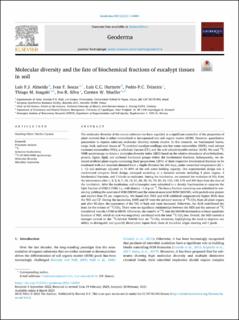| dc.description.abstract | The molecular diversity of the source substrate has been regarded as a significant controller of the proportion of plant material that is either mineralized or incorporated into soil organic matter (SOM). However, quantitative parameters to express substrate molecular diversity remain elusive. In this research, we fractionated leaves, twigs, bark, and root tissues of 13C-enriched eucalypt seedlings into hot water extractables (HWE), total solvent (acetone) extractables (TSE), a cellulosic fraction (CF), and the acid unhydrolyzable residue (AUR). We used 13C NMR spectroscopy to obtain a molecular diversity index (MDI) based on the relative abundance of carbohydrate, protein, lignin, lipid, and carbonyl functional groups within the biochemical fractions. Subsequently, we obtained artificial plant organs containing fixed proportions (25%) of their respective biochemical fractions to be incubated with soil material obtained from a Haplic Ferralsol for 200-days, under controlled temperature (25 ± 1 ◦C) and moisture adjusted to 70–80% of the soil water holding capacity. Our experimental design was a randomized complete block design, arranged according to a factorial scheme including 4 plant organs, 4 biochemical fractions, and 3 blocks as replicates. During the incubation, we assessed the evolution of CO2 from the microcosms after 1, 2, 3, 4, 7, 10, 13, 21, 28, 38, 45, 70, 80, 92, 112, 148, 178 and 200 days from the start of the incubation. After the incubation, soil subsamples were submitted to a density fractionation to separate the light fraction of SOM (LFOM) i.e., with density <1.8 g cm 3. The heavy fraction remaining was submitted to wetsieving yielding the sand-sized SOM (SSOM) and the mineral-associated SOM (MAOM), with particle-size greater and smaller than 53 μm, respectively. We found that HWE and AUR exhibited comparatively higher MDIs than the TSE and CF. During the incubation, HWE and CF were the primary sources of 13C-CO2 from all plant organs and after 92 days, the respiration of the TSE of bark and roots increased. Otherwise, the AUR contributed the least for the release of 13C-CO2. There were no significant relationships between the MDI and the amount of 13C transferred into the LFOM or SSOM. Otherwise, the transfer of 13C into the MAOM increased as a linear-quadratic function of MDI, which in turn was negatively correlated with the total 13C-CO2 loss. Overall, the MDI exerted a stronger control on the 13C-labeled MAOM than on 13C-CO2 emissions, highlighting the need to improve our ability to distinguish and quantify direct plant inputs from those of microbial origin entering soil C pools. | en_US |
